A review of the new 13-inch MacBook Pro with Retina Display so closely following a review of the 15-inch model has many layers. In isolation, the 13-inch Pro is just a smaller version of its well-regarded bigger brother, and so it’s easy to set expectations. But more broadly, the new 13-inch Pro is much more than that: it’s a logical endpoint for a number of Apple and tech industry trend lines and the start of a new wave altogether. It’s a mainstream laptop that uses all the space-saving tricks and techniques Apple learned building the MacBook Air to be as thin and light as possible, but still offers up a powerful Intel processor and a seven-hour battery life. The design language follows right along with the recently-introduced 15-inch Retina Macbook Pro, which itself was a subtle iteration on the MacBook Pro before it. And it has that Retina display — a technology that remains unmatched in the PC market.
None of this is surprising, but that’s not a bad thing: the 13-inch Pro is a predictable product in the same way that opening a present and receiving exactly the thing you’d wished for is a predictable experience. Apple has a playbook, and the new 13-inch Pro follows it closely. And as Apple’s most popular Mac, the 13-inch Pro tells us a lot about what Apple thinks mainstream computers should look like — which usually tells us a lot about what other PC manufacturers will think mainstream computers should look like.
But now that we’ve unwrapped this thing, does it live up to all these expectations? Can its relatively midrange internals handle the burden of that beautiful display? Is the $1,699 13-inch Pro worth the upgrade over the $1,199 13-inch Air, until now the laptop we’ve most often recommended? Most importantly, is this your next laptop? Read on to find out.
Unlike the 15-inch Retina MacBook Pro, the size and weight reduction of the 13-inch Pro isn’t nearly as shocking in person — the older 13-inch Pro already felt quite small, and the ubiquitous 13-inch Air is just slightly thinner at its thickest point. And the Air is actually a little bigger in terms of height and width. Basically, you’re used to Apple making laptops of about this size, and the Retina 13 is a nice midpoint between the old Pro and the Air.
| Dimensions (in.) | Thickness (in.) | Weight (lbs) | |
|---|---|---|---|
| MacBook Pro with Retina display (13-inch) | 12.35 x 8.62 | 0.75 | 3.57 |
| MacBook Pro with Retina display (15-inch) | 14.13 x 9.73 | 0.71 | 4.46 |
| MacBook Pro (2012, 13-inch) | 12.78 x 8.94 | 0.95 | 4.5 |
| MacBook Air (2012, 13-inch) | 12.8 x 8.94 | 0.11-0.68 | 2.96 |
You'll notice an improvement in Apple’s already industry-leading fit and finish, though: the 13 uses the same new riff on unibody MacBook design as the 15-inch Retina, and it’s an extremely stiff, solid machine. It’s also extremely clean, with no branding on it apart from the Apple logo on the lid and the regulatory stuff on the bottom — even the "MacBook Pro" insignia under the screen has been done away with. And the little indent in front of the trackpad has been slightly smoothed out and made less concave. Everything’s just a little tighter than before.
The backlit keyboard and glass multitouch trackpad are up to Apple’s usual high standards, although if you’re coming to the Pro from an Air you’ll notice the increased key travel Apple employs on Pro machines. Around the left side you’ll find the new thinner MagSafe 2 power connector, two Thunderbolt ports, a USB 3.0 port, and a headphone jack. On the right, there’s another USB 3.0 port, an HDMI port, and an SD card slot. It’s a nice improvement over the previous arrangement that had all the ports crammed up on one side, and the HDMI jack is particularly welcome — it’s the first industry-standard video connector Apple’s built into a laptop in years, and I’m hoping it supplants VGA... sometime. And you can obviously still use mini DisplayPort cables and adapters with the Thunderbolt ports if you have an existing display or projector.
Do keep in mind that the reduced size means you’re losing Ethernet, FireWire, and an optical drive. The vast majority of people probably won’t miss them, but if you’re a traveler you’ll probably want to spring for the $29.99 Thunderbolt-to-Ethernet adapter in case of emergencies.
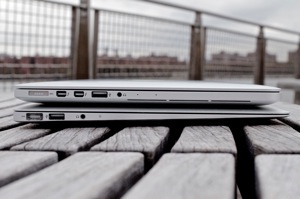


Retina display
This is what computer screens should look like from now on
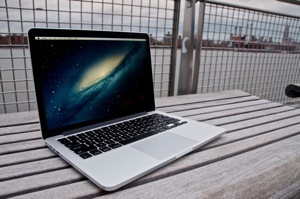
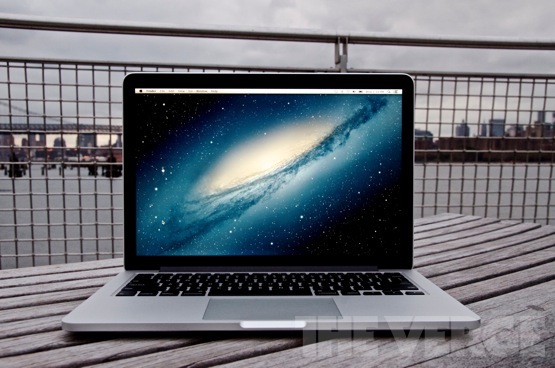
There are no superlatives left for Apple’s Retina displays — the company is leading the industry in shipping ultra-high-resolution screens and building software to take advantage of them. And while others are starting to catch up on smartphones and tablets, there’s simply no match in the laptop world. This is what computers should look like from now on.
Apple’s basic trick is a simple one: where a traditional display has a single pixel, a Retina display has four — but the extra pixels are used to make everything sharper, not provide more screen real estate. Quadrupling pixel density in this way means the Retina 13 has a 226ppi 2560 x 1600 display where the previous Pro had a 113ppi 1280 x 800 display, but the effective screen area at the default "best" setting is still 1280 x 800.
Put more simply, you’re seeing the same amount of stuff out of the box as the previous 13-inch MacBook Pro, but — assuming you’re looking at a Retina-enhanced app — you’re seeing it far more beautifully.
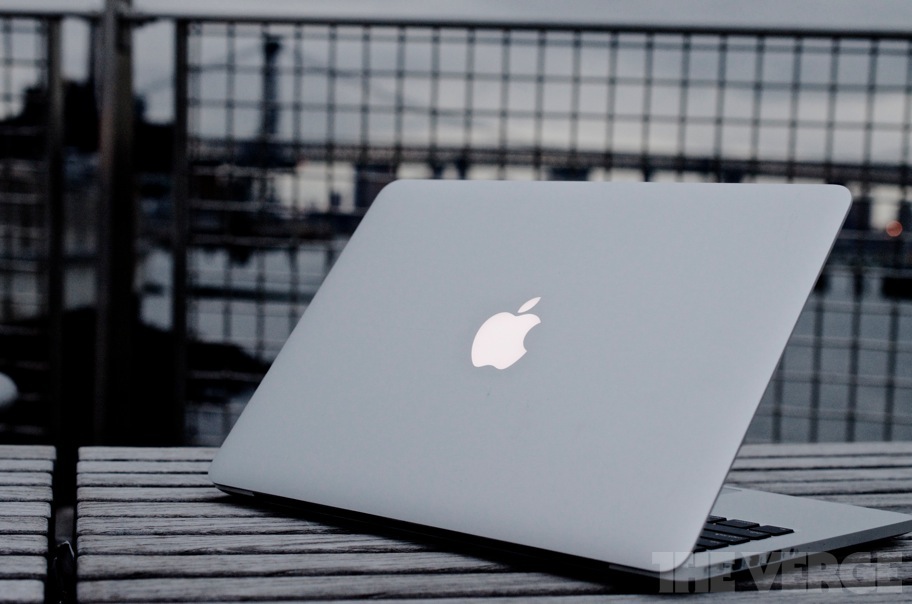
Living in a retina world
The good news is that lots of apps have been Retina-enhanced since the 15-inch Pro came out. All of Apple’s pro and consumer apps are enhanced, of course, and major apps like Office, Chrome, and Adobe Premiere have all been updated in the past few months. (Adobe’s also promised an update for many other apps, including Photoshop CS6 and Lightroom, in the fall.) And Apple maintains an entire section of Retina-enhanced apps in the Mac App Store if you’re looking for more, with indie favorites like Evernote, Day One, Pixelmator, and Tweetbot all offering support.
The bad news is things can look like garbage if you’re not looking at Retina-enhanced content. The now-deprecated Twitter app is probably the most egregious example: it looks so blurry and out of place on this display that it’s just sad. And while web browsers like Chrome and Safari have been updated for the Retina display, the web itself is still catching up: you’ll notice blurry low-res images everywhere, and sites like Facebook and YouTube that mix Retina-enhanced text and icons with standard assets look fairly messy. Things are improving rapidly, but for now potential Retina owners should take a note from Victor Ward: the better you look, the more you see.
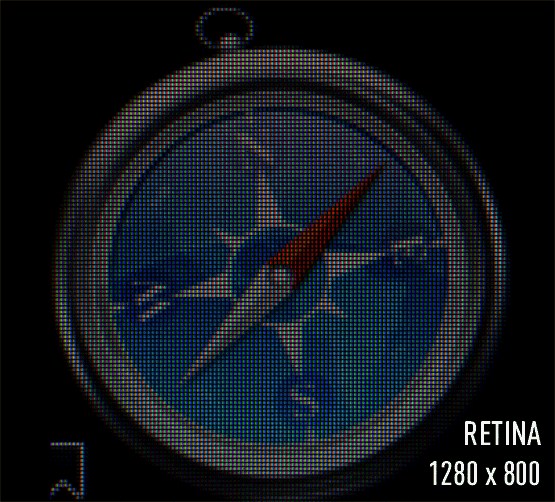
Lastly, it’s important to note that 1280 x 800 isn’t actually a huge amount of screen real estate. It’s about the same as the standard 13-inch Windows laptop resolution of 1366 x 768, but it’s noticeably smaller than the 1440 x 900 on a MacBook Air. Everything is far more beautiful at the Retina setting on the 13-inch Pro, but you’ll have less working space than you might be used to.
You can go into the display options and switch to 1440 x 900, which still looks nice, but you lose a hair of Retina crispness since you’re scaling to a non-native resolution. Think about it this way: where the Retina "best" setting fits each pixel of a 1280 x 800 image perfectly onto four pixels of a 2560 x 1600 screen, each pixel of a 1440 x 900 image fits imperfectly onto 3.6 pixels of the display, so it’s a little bit blurrier. You might not notice it, but it still isn’t what you’re paying for. And running at higher resolutions imparts a performance penalty, which isn't good news on this machine — more on that in a bit.
(You can also set the display to a max of 1680 x 1050, which I was very excited about since that’s the same workspace as my older 15-inch Pro, but it’s just too tiny for my eyes.)
Overall, the 13-inch Retina display stands alongside the 15-inch as one of the best displays to ever ship on a laptop, but the simple fact is that I never used the "best" Retina setting and instead left it at 1440 x 900. The good news is that the technology is improving quickly: Google and Samsung are already shipping a 300ppi 10-inch display on the Nexus 10 at the same resolution as this 13-inch Retina MacBook Pro. Apple just has to find a way to ship 255ppi displays: a 2880 x 1800 13.3-inch display on the 13-inch MacBook Pro would run natively at 1440 x 900, and a 3360 x 2100 15.6-inch display on the 15-inch Pro would run natively at 1680 x 1050.
But for now, the 13-inch Pro offers a tiny beautiful window onto a tragically imperfect world. Unfortunately, that gorgeous face is often betrayed by a rather pedestrian mind.

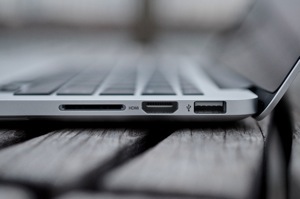
The better you look, the more you see
Performance and battery life

The 2.5GHz Core i5 in the 13-inch Pro offers terrific raw CPU performance in benchmarks, running Geekbench at a solid 6700-6800 range, but the integrated Intel HD 4000 graphics chip can struggle driving such a high-resolution display. Oddly, it showed up for me more during day-to-day usage than under any crazy test situation I came up with: RAW files in Aperture scroll around just fine while QuickTime is playing back 1080p movie trailers, but Safari and Chrome both stutter a little while scrolling simple web pages. And they stutter a lot with image-heavy sites like The Verge and Polygon.
You’ll also notice some general lag when you start multitasking heavily. Open more than a few tabs and apps and you’ll start to notice things slowing down around the system as a whole. My standard workday set of 15-20 tabs open in Chrome, music playing in Spotify, email and IRC open, and Skype, iPhoto, and Messages running in the background never pegged the CPU meter, but I could clearly feel the system running just a hair behind me. You might not notice it if you’re coming from an Air or a much older MacBook, but I’m used to my 15-inch Pro with 2.3GHz Core i7 and Radeon HD 6750M graphics, and and the 13-inch Retina is definitely a little slower. If you’re a pro looking to step down to a smaller machine, you’ll almost certainly notice the performance dropoff as well.
The simple fact is that Retina display is a lot of pixels to push around for that graphics chip — just consider that Apple uses the same GPU in the MacBook Air, which has a third of the pixels and can still be made to drop frames under heavy multitasking loads. Plug in an external monitor and you’ll feel the hit come even quicker in day-to-day use — I tried both my 1080p TV over HDMI and my 24-inch 1920 x 1080 display over mini DisplayPort, and I could make YouTube videos stutter on one display simply by loading The Verge in the other.
The graphics chip struggles to drive that display

If you're expecting your investment to last a few years, look elsewhere
In terms of gaming performance, there isn’t much. A newer, heavier game like The Witcher 2: Assassins of Kings was absolutely unplayable: I couldn’t even watch the opening cutscene, and there was so much input lag it took me a few tries to get the mouse arrow onto the quit menu to stop the pain. Things are passable if you stick to older games, but nothing to write home about. I generally saw 60fps and under running Half-Life 2: Episode 2 at 1280 x 800 and default settings, and rarely saw it go past 90fps. Setting it to 1680 x 1050 meant I never saw anything more than 45fps. Portal 2 comes capped at 60fps at the default settings but I spent most of my time at around 50fps, and turning off the cap didn’t do much.
The base $1,699 configuration gives you 8GB of RAM and a 128GB SSD. That’s it, forever: neither is easily upgradeable, and you can’t order a 13-inch with 16GB of RAM as you can with the 15-inch Pro. And a 128GB hard drive is not a lot of storage, especially for a primary machine; the 128GB SSD in my work laptop is always running close to full, and I barely keep any music or photos on it at all. Upgrading to a 256GB drive will run you another $300 for a total of $1,999 — at which point you should bite the bullet and spend $2,199 on a 15-inch Retina MacBook Pro that offers the same storage space, a higher screen resolution, a faster Core i7 processor, and a discrete GPU that does a far better job of moving all those pixels around. It is an absolutely huge increase in performance for an extra 10 percent in cost. No one should buy the $1,999 13-inch Pro with the 15-inch model sitting right there.
Ultimately it feels like the 13-inch Pro is already pushing up against the edge of its performance envelope — it’ll probably be fine if you’re a pro who absolutely needs the beautiful display and you upgrade frequently, but if you’re expecting your $1,699 investment to last a few years, you should look elsewhere. And if you’re thinking about spending $1,999 on the model with more storage, you should find a way to buy the 15-inch Retina Pro instead.
Battery Life
Battery life was surprisingly decent on the 13-inch Pro, clocking in at 6 hours and 18 minutes on the Verge battery test, which cycles through a series of websites over Wi-Fi at 65 percent brightness. In more general use, I routinely got around 5.5 hours just going about my daily routine without regard for battery life. That compares favorably to the Air, which gets close to 7 hours on our test and usually runs for about 5.5 to 6 hours in daily use, and it’s much better than the 15-inch Retina Pro, which only ran for 5 hours in our test. You’re essentially sacrificing a little of the Air’s battery life to run the display and slightly beefier processor. It’s not a terrible tradeoff, but you should be aware of it.

A tantalizing glimpse of the future limited by the reality of the present
I spent the entire time I was reviewing the 13-inch MacBook Pro with Retina Display thinking about the MacBook Air. Not the current Air, which has become the best overall laptop on the market, but the very first Air — the one from 2008 that was ridiculously underpowered, featured terrible integrated Intel graphics, had just 2GB of RAM and an 80GB hard drive, and cost an absurd $1,799. I know people who bought that computer and felt an immediate combination of intense love and deep regret — while it was blindingly clear that all laptops would be that thin and beautiful in the future, it was equally clear that Apple was too far ahead of the performance curve in the present. Four years later, the Air has become Apple’s mainstream product and the PC industry is still working to catch up. The curve has flattened out.It’s the same thing with the 13-inch Pro — it’s hard not to love this thing when you first see it. Just look at that screen. But you’re paying a lot of money for a computer that once again offers a single tantalizing glimpse of the future only to be limited by the realities of the present in almost every other way. One day all computer displays will look this good. One day we’ll sit around campfires, drinking moonshine and telling our children nightmare tales of visible pixels and display resolutions under 200ppi. That day will be wonderful. It will also have a reasonable graphics chip, more than 128GB of storage, and cost less than $1,699.Until that day comes, you should either trade up to the 15-inch MacBook Pro with Retina Display or buy a MacBook Air and save your wistful Retina dreams for a $499 iPad on the side.
:format(webp)/cdn.vox-cdn.com/uploads/chorus_asset/file/12799499/2012-10-31rmbp13review1020-14.1419978976.jpg)
:format(webp)/cdn.vox-cdn.com/uploads/chorus_asset/file/12799499/2012-10-31rmbp13review1020-14.1419978976.jpg)
Share this story